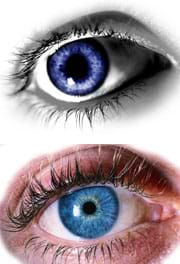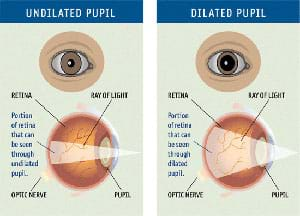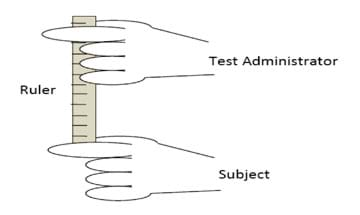Quick Look
Grade Level: 6 (6-8)
Time Required: 30 minutes
Expendable Cost/Group: US $0.00
Group Size: 2
Activity Dependency:
Subject Areas: Biology, Life Science, Science and Technology
NGSS Performance Expectations:

| MS-LS1-8 |

Summary
Students observe and test their reflexes, including the (involuntary) pupillary response and (voluntary) reaction times using their dominant and non-dominant hands, as a way to further explore how reflexes occur in humans. They gain insights into how our bodies react to stimuli, and how some reactions and body movements are controlled automatically, without conscious thought. Using information from the associated lesson about how robots react to situations, including the stimulus-to-response framework, students see how engineers use human reflexes as examples for controls for robots.Engineering Connection
Biological engineers and neuroscientists perceive human bodies as functioning, controlled systems, not unlike robots. Research is increasingly revealing that mathematical principles similar to those used in robotics are extremely useful or even necessary for a complete understanding of the human body. As an example of how engineers get ideas from human reflexes, painting robots are designed to take input from vision sensors in order to continuously move the robot sprayer tip so it is always positioned at the right distance from the car body as it paints.
Learning Objectives
After this activity, students should be able to:
- List typical human reaction times.
- Explain how the "stimulus-sensor-coordinator-effector-response" loop works in humans and in robots.
Educational Standards
Each TeachEngineering lesson or activity is correlated to one or more K-12 science,
technology, engineering or math (STEM) educational standards.
All 100,000+ K-12 STEM standards covered in TeachEngineering are collected, maintained and packaged by the Achievement Standards Network (ASN),
a project of D2L (www.achievementstandards.org).
In the ASN, standards are hierarchically structured: first by source; e.g., by state; within source by type; e.g., science or mathematics;
within type by subtype, then by grade, etc.
Each TeachEngineering lesson or activity is correlated to one or more K-12 science, technology, engineering or math (STEM) educational standards.
All 100,000+ K-12 STEM standards covered in TeachEngineering are collected, maintained and packaged by the Achievement Standards Network (ASN), a project of D2L (www.achievementstandards.org).
In the ASN, standards are hierarchically structured: first by source; e.g., by state; within source by type; e.g., science or mathematics; within type by subtype, then by grade, etc.
NGSS: Next Generation Science Standards - Science
| NGSS Performance Expectation | ||
|---|---|---|
|
MS-LS1-8. Gather and synthesize information that sensory receptors respond to stimuli by sending messages to the brain for immediate behavior or storage as memories. (Grades 6 - 8) Do you agree with this alignment? |
||
| Click to view other curriculum aligned to this Performance Expectation | ||
| This activity focuses on the following Three Dimensional Learning aspects of NGSS: | ||
| Science & Engineering Practices | Disciplinary Core Ideas | Crosscutting Concepts |
| Gather, read, and synthesize information from multiple appropriate sources and assess the credibility, accuracy, and possible bias of each publication and methods used, and describe how they are supported or not supported by evidence. Alignment agreement: | Each sense receptor responds to different inputs (electromagnetic, mechanical, chemical), transmitting them as signals that travel along nerve cells to the brain. The signals are then processed in the brain, resulting in immediate behaviors or memories. Alignment agreement: | Cause and effect relationships may be used to predict phenomena in natural systems. Alignment agreement: |
Common Core State Standards - Math
-
Summarize numerical data sets in relation to their context, such as by:
(Grade
6)
More Details
Do you agree with this alignment?
-
Reporting the number of observations.
(Grade
6)
More Details
Do you agree with this alignment?
-
Describing the nature of the attribute under investigation, including how it was measured and its units of measurement.
(Grade
6)
More Details
Do you agree with this alignment?
International Technology and Engineering Educators Association - Technology
-
Explain how knowledge gained from other content areas affects the development of technological products and systems.
(Grades
6 -
8)
More Details
Do you agree with this alignment?
State Standards
Missouri - Science
-
Identify receivers of visible light energy (e.g., eye, photocell)
(Grade
6)
More Details
Do you agree with this alignment?
-
Make qualitative observations using the five senses
(Grade
6)
More Details
Do you agree with this alignment?
Materials List
Each group needs:
- meter-length ruler, wooden or plastic
- pencil, one per student
- Response & Reaction Worksheet, one per student
To share with the entire class:
- computer and projector to show the Response & Reaction Presentation to the class
Worksheets and Attachments
Visit [www.teachengineering.org/activities/view/umo_ourbodies_lesson03_activity5] to print or download.Pre-Req Knowledge
Although not required, we suggest students complete the previous unit in the series, Humans Are Like Robots and the previous lessons and activities of this unit, prior to starting this activity.
Introduction/Motivation
A reflex is an involuntary and nearly instantaneous movement made by the body in response to a stimulus. In some instances, the body reacts to a stimulus without having to send a signal to the brain. Local nerves process the information from the stimulus and react to it automatically. Reflexes are an automatic defense mechanism from the body.
Can you think of instances in which it would be important for the body to react swiftly in order to protect the body so that it makes sense that it reacts without sending a message to the brain first? (See what scenarios students suggest. Possible answers: Pulling back your hands or limbs quickly from touching something hot, sharp or unknown, to protect the body; changing pupil size as you move from daylight into a tunnel or shady area and back into full sunshine, all the while generating continual vision, making the pupil smaller and/or blinking when objects like balls, branches, dust or other people come too close to the eyes, to protect the eyes.)
What are some human reflexes that you know about or have heard about? (Possible answers, many of them mentioned in the associated lesson: knee jerk reflex [patellar reflex], blinking [corneal reflex], blushing, hands touching hot objects, acoustic reflex, rooting reflex, shivering, vestibule-ocular reflex, sneezing, ankle jerk, biceps reflex, coughing, gag reflex, accommodation reflex [coordinated eye lens shape and pupil size adjustments when looking at a distant object after a near object], and pupillary light reflex.)
Let's do some experimenting to test our own reflexes and reactions.
Procedure
Before the Activity
- Gather materials and make copies of the worksheets.
- Be ready to show the class the Response & Reaction Presentation PowerPoint file.
Background
With information provided on the eight presentation slides, oversee students as they conduct two short exercises (10 minutes + 25 minutes) on the pupillary light reflex response and hand reaction times. Have students work in pairs, using the worksheet to guide their testing and data collection.
With the Students

- Divide the class into groups of two students each. Hand out the worksheets.
- Allow 10 minutes for student pairs to conduct exercise 1, observing their pupillary light reflex responses (slide 2). Instructions (also on the slide and worksheet):
- Perform this exercise with a partner.
- Dim the room lights. After a few minutes, look at the eyes of your partner and note the pupil sizes (the black center spots in the middle of the eyes).
- Turn on the room lights. Check the pupil sizes again. The pupils should now be smaller.
- This is the pupillary light reflex response. This reflex "automatically" keeps out excessive light that may damage the eyes, and thus protects your eyes for you!
- Allow 25 minutes for student pairs to conduct exercise 2, testing reaction times (slides 2-6). Explain the exercise and review the instructions so they are clear to students: In your groups, you will perform four variations of a reaction test. As you collect data, fill in the worksheet data table. Then switch roles and repeat the tests and data collection. As necessary, demonstrate for students the ruler drop-n-catch set-up. Then let the student pairs proceed to conduct their own tests and collect data. Instructions (also on the slides and worksheet):

How to hold the ruler.
- For Test A: Hold a meter-long ruler near the end with the highest number and let it hang down. Have your partner put his/her dominant hand at the bottom of the ruler, not touching it, and be ready to grab the ruler when it drops. Tell your partner that you will drop the ruler sometime in the next five seconds with no countdown warning and that s/he is to try to catch the ruler as fast as s/he can after you drop it. Be consistent in where hands are placed at the start of each trial. Record in the data table the point on the ruler (centimeters or inches) at which your partner catches it. Repeat this test with the same subject for a total of three times. Vary the time of dropping within the five-second "drop-zone" so the subject cannot guess when you will drop the ruler.
- For Test B: Conduct the same test with the addition of a countdown warning. Tell your partner that you will drop the ruler at the count of three and say: 1... 2... 3 and drop it when you say 3. Record in the data table the point on the ruler where the partner caught it for this trial. Repeat this test with a countdown with the same subject for a total of three times.
- For Test C: Conduct the test with no countdown warning and your partner's eyes closed. Tell your partner that you will drop the ruler any time within a five-second "drop-zone." Record the data.
- For Test D: Conduct the test with a countdown warning, eyes closed, with the subject using his/her non-dominant hand. Tell your partner that you will drop the ruler at the count of three and say: 1... 2... 3 and drop it when you say 3. Record the data.
- Have students share and discuss their exercise 2 findings as a class. Then either have students answer the six worksheet results and analysis questions (slide 7) in writing or lead a class discussion using the questions as prompts.
- Conclude by administering the three-question Post-Lesson Quiz (slide 8, and attachment to associated lesson). As a class, summarize and highlight the key concepts:
- A reflex is an involuntary and nearly instantaneous body movement in response to a stimulus that is largely done for self-defense and self-preservation purposes.
- Response time is the sum of reaction time and movement time.
- Human reflexes and robot actions can be described using the "stimulus-sensor-coordinator-effector-movement" framework, which is very useful to understand both human and engineering systems.
Vocabulary/Definitions
reflex: An involuntary and nearly instantaneous body movement in response to a stimulus, largely for self-defense and self-preservation.
response time: The sum of reaction time and movement time.
Assessment
Pupillary Response: After the pupillary response exercise, have students discuss their findings in groups, particularly if any differences were observed.
Test Reaction Times: After testing their reaction times, have students share and discuss as a class their findings. Then either have students answer the six Response & Reaction Worksheet results and analysis questions in writing to be turned in for grading or lead a class discussion using the questions as prompts. Consider student answers and/or discussion contributions to gauge their comprehension.
Wrap-Up Quiz: Wrap up the lesson/activity set by administering the three-question post-lesson quiz, provided on slide 8 and as the Human & Robot Reflexes Post-Lesson Quiz attachment to the associated lesson. Answers are provided in the slide 8 notes, and as an attachment in the associated lesson.
Activity Scaling
- For more advanced students, provide additional explanatory material as found at the websites listed in the References section.
Subscribe
Get the inside scoop on all things TeachEngineering such as new site features, curriculum updates, video releases, and more by signing up for our newsletter!More Curriculum Like This

Students learn about human reflexes, how our bodies react to stimuli and how some body reactions and movements are controlled automatically, without thinking consciously about the movement or responses. In the associated activity, students explore how reflexes work in the human body by observing an ...

Students learn about the function and components of the human nervous system, which helps them understand the purpose of our brains, spinal cords, nerves and five senses. In addition, how the nervous system is affected during spaceflight is also discussed.

Students learn about the similarities between the human brain and its engineering counterpart, the computer. Since students work with computers routinely, this comparison strengthens their understanding of both how the brain works and how it parallels that of a computer.

With the challenge to program computers to mimic the human reaction after touching a hot object, students program LEGO® robots to "react" and move back quickly once their touch sensors bump into something. By relating human senses to electronic sensors used in robots, students see the similarities b...
References
Dowshen, Steven. What Are Reflexes? Last updated September 2010. Kids Health from Nemours. Accessed April 16, 2013. http://kidshealth.org/kid/talk/qa/reflexes.html
List of reflexes (alphabetical). Last updated November 3, 2012. In Wikipedia, The Free Encyclopedia. Accessed April 16, 2013. http://en.wikipedia.org/w/index.php?title=List_of_reflexes_(alphabetical)&oldid=521175984
Mental chronometry. Last updated March 2, 2013. In Wikipedia, The Free Encyclopedia. Accessed April 16, 2013. http://en.wikipedia.org/w/index.php?title=Mental_chronometry&oldid=541675578
Your Sense of Touch. The Senses, Oracle ThinkQuest. Accessed April 16, 2013. http://library.thinkquest.org/3750/touch/touch.html
Copyright
© 2013 by Regents of the University of Colorado; original © 2012 Curators of the University of MissouriContributors
Marianne Catanho, Sachin Nair, Charlie Franklin, Satish NairSupporting Program
GK-12 Program, Computational Neurobiology Center, College of Engineering, University of MissouriAcknowledgements
This curriculum was developed under National Science Foundation GK-12 grant no. DGE 0440524. However, these contents do not necessarily represent the policies of the National Science Foundation, and you should not assume endorsement by the federal government.
Last modified: March 28, 2019







User Comments & Tips